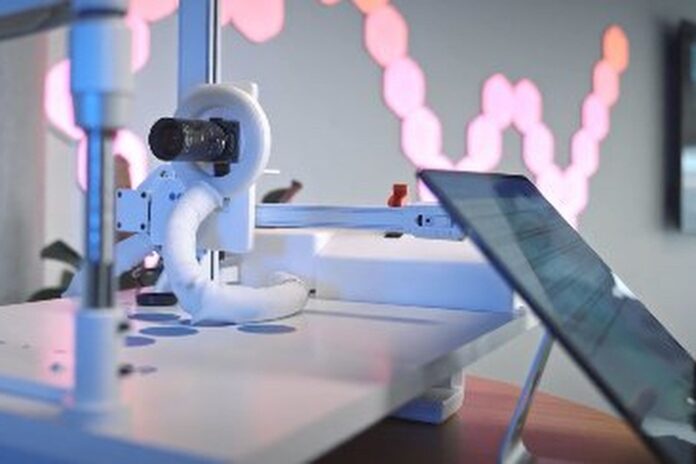The solutions monitor patients’ eyes to judge if cataract surgery is needed yet and white blood cells in cancer patients undergoing treatment
Telefónica will present two new healthcare solutions at Mobile World Congress (MWC) which takes place in Barcelona from 3-6 March. They use 5G, edge computing and AI to determine the need for surgery in people with cataracts and monitor the level of white blood cells in cancer patients.
Monitoring eyes for cataracts
CatEye (pictured) consists of a device connected via 5G that can determine whether a patient’s cataracts are sufficiently developed to warrant surgery. This solution was developed by Telefónica in collaboration with Edgendria Innovación, a specialist optics platform with precision servomotors applied to a specific camera. The camera can perform autonomously, without specialist oversight, to photograph both eyes. The images are sent via 5G to an AI-enabled app housed in Telefónica’s edge.
The AI identifies certain parameters to decide whether the cataract is incipient or requires intervention by an ophthalmologist. Edgendria Innovación designed and built the device, and integrated AI into it. CatEye could allow specialist ophthalmologists to delegate certain tasks to their team so they only intervene at the right time, making better use of their time and expertise.
The device is “relatively easy to transport”, apparently, and can be used by a technician. It can be taken to areas that lack healthcare resources.
Blood monitoring
5G Intelligent Blood Monitoring comprises 5G and edge computing provided by Telefónica and the PointCheck solution developed by startup Leuko. It is intended to improve monitoring of patients who are critically ill and who might suffer severe neutropenia, which means that neutrophils, a type of white blood cell, has fallen below the threshold of 500/µl. This sometimes happens to oncology patients due to the effect of certain drugs or other pathologies, and it exposes them to high risk of infection.
Leuko’s PointCheck is a non-invasive device that captures the blood circulation on video in the capillaries of the patients’ ring finger. The video is analysed by a specially trained algorithm to infer whether the patient is at risk of severe neutropenia.
The integration of 5G with the PointCheck device allows the patient to perform this test wherever they are, reliably, securely. and According to the operator, the link provides the right levels of latency and bandwidth to transmit the video plus the metadata for analysis.
In this pilot Telefónica has also deployed the algorithm at its edge to maintain the sovereignty and security of medical data, as it does not leave the operator’s network from capture until it is delivered to medical staff.
This solution means patients can avoid trips to hospital where there is a higher risk of infection and makes routine health checks quicker and easier. It also helps the healthcare system optimise resources as the device can be used in patients’ homes or in pharmacies or rural health centres, providing easier access to healthcare for a higher percentage of the population.
CatEye and 5G Intelligent Blood Monitoring are being promoted by Telefónica Spain Innovation with the aim of putting technology at the service of patients and healthcare professionals, increasing data transmission capacity, and minimising latency.
Protagonists in the Telefónica Agora
The solutions be showcased as part of the presentation Technologies for health, from CatEye to 5G Smart Blood Monitoring and Internet of Things at the Telefónica Agora at MWC on Wednesday 5 March, from 11:30am to 12:15pm.
Micaela Martelli, Director of Sector Solutions at Telefónica Spain, comments, “Healthcare in Spain faces several challenges due to the fact that we have one of the highest longevity rates in the world, which implies an increase in chronic diseases.
“Faced with this challenge, technology helps to improve the planning and efficiency of the healthcare system, as well as to optimize the patient experience. With the 5G network, Telefónica enables the development of technological projects focused on solving specific medical situations, such as CatEye and 5G Intelligent Blood Monitoring”.


